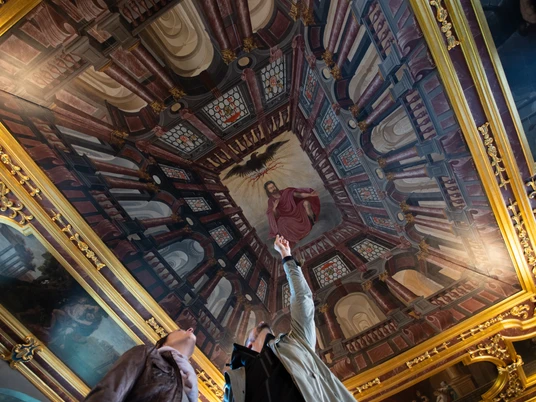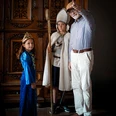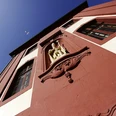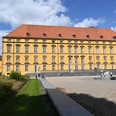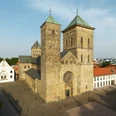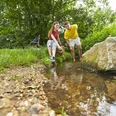How did you actually impress neighbours and relatives long before there were cars? One answer can be found at Iburg Castle in the "Knights' Hall", one of the younger rooms in the ancient building with its baroque interior. Its ceiling is adorned with a painting that is considered "perspective illusion architecture" - a rare attraction north of the Alps in the 17th century and one of the few surviving paintings of its kind today. The ceiling painting creates the illusion that the viewer is standing in a huge ancient temple, with Zeus, the Greek father of the gods, enthroned on high. An optical illusion that is just as confusing to the viewer as it sounds here.
The portraits of all the Osnabrück bishops who resided at Iburg Castle until the end of the 17th century hang on the walls. The first was Bishop Wiho (died around 804), one of his most important successors was Benno II, who had the new Iburg built on an old ruin in 1068 - including the church, of course. He also founded the first monastery and soon pious Benedictines moved into the neighbourhood. Most of his successors added to or altered the castle complex, making the guided tour a journey through almost ten centuries. Prince-Bishop Philip Sigismund von Braunschweig-Wolfenbüttel was probably the most eager master builder, who around 1600 had the castle mill on Charlottensee and the hunting lodge on the southern hillside built in addition to the four-winged Renaissance complex, which is still largely preserved today. The Knights' Hall with its ceiling painting was added by Prince-Bishop Franz Wilhelm von Wartenberg after the Thirty Years' War.
This ended in 1648 with the Peace of Westphalia, which was negotiated and proclaimed in Münster and Osnabrück. One of the regulations: Catholic and Protestant prince-bishops alternated in the diocese of Osnabrück for 150 years - there was nothing like this anywhere else. The first Protestant, Ernst August von Braunschweig-Lüneburg, had a Lutheran castle church built in addition to the old monastery church - something else that is hard to find anywhere else. His daughter Sophie Charlotte was born at Iburg in 1668. She would later become the first queen of Prussia. As there are also close links to the British royal family, a tour of the castle at Iburg always includes a few anecdotes and a bit of gossip about the old European aristocracy.
By the way, by 1673, Iburg was no longer enough to make a lasting impression on others: Ernst August therefore had the Osnabrück City Palace built and moved his residence there.
Today, the huge Iburg Castle, which belongs to the state of Lower Saxony, houses the district court, the Bad Iburg police station, the State Construction Management Northwest and the castle museum. Nevertheless, there are still plenty of rooms with historical furnishings that can be visited - from the dungeon in the keep to the bishop's living quarters.
Guided castle tours
April-October: Friday-Sunday 15:00
November-March: Saturday and Sunday 15:00
The portraits of all the Osnabrück bishops who resided at Iburg Castle until the end of the 17th century hang on the walls. The first was Bishop Wiho (died around 804), one of his most important successors was Benno II, who had the new Iburg built on an old ruin in 1068 - including the church, of course. He also founded the first monastery and soon pious Benedictines moved into the neighbourhood. Most of his successors added to or altered the castle complex, making the guided tour a journey through almost ten centuries. Prince-Bishop Philip Sigismund von Braunschweig-Wolfenbüttel was probably the most eager master builder, who around 1600 had the castle mill on Charlottensee and the hunting lodge on the southern hillside built in addition to the four-winged Renaissance complex, which is still largely preserved today. The Knights' Hall with its ceiling painting was added by Prince-Bishop Franz Wilhelm von Wartenberg after the Thirty Years' War.
This ended in 1648 with the Peace of Westphalia, which was negotiated and proclaimed in Münster and Osnabrück. One of the regulations: Catholic and Protestant prince-bishops alternated in the diocese of Osnabrück for 150 years - there was nothing like this anywhere else. The first Protestant, Ernst August von Braunschweig-Lüneburg, had a Lutheran castle church built in addition to the old monastery church - something else that is hard to find anywhere else. His daughter Sophie Charlotte was born at Iburg in 1668. She would later become the first queen of Prussia. As there are also close links to the British royal family, a tour of the castle at Iburg always includes a few anecdotes and a bit of gossip about the old European aristocracy.
By the way, by 1673, Iburg was no longer enough to make a lasting impression on others: Ernst August therefore had the Osnabrück City Palace built and moved his residence there.
Today, the huge Iburg Castle, which belongs to the state of Lower Saxony, houses the district court, the Bad Iburg police station, the State Construction Management Northwest and the castle museum. Nevertheless, there are still plenty of rooms with historical furnishings that can be visited - from the dungeon in the keep to the bishop's living quarters.
Guided castle tours
April-October: Friday-Sunday 15:00
November-March: Saturday and Sunday 15:00
Good to know
Openings
Castle Museum
Opening hours: Fri., Sat. & Sun. 2 to 5 p.m.
Knights' Hall
Opening hours (May to October): Mon.-Thurs. 2 - 4 p.m.
Opening hours: Fri., Sat. & Sun. 2 to 5 p.m.
Knights' Hall
Opening hours (May to October): Mon.-Thurs. 2 - 4 p.m.
Price info
Castle Museum:
Admission: 3€, reduced 2,50€
Opening hours: Fri., Sat. & Sun. 2 to 5 p.m.
Combined ticket (castle museum + castle tour): €6.50 / €5.50
Knights' Hall: 2,- € / 1,- €
Opening hours (May to October): Mon.-Thurs. 2-4 p.m.
Guided tour of the castle: 5,- € / 4,50 €
Admission: 3€, reduced 2,50€
Opening hours: Fri., Sat. & Sun. 2 to 5 p.m.
Combined ticket (castle museum + castle tour): €6.50 / €5.50
Knights' Hall: 2,- € / 1,- €
Opening hours (May to October): Mon.-Thurs. 2-4 p.m.
Guided tour of the castle: 5,- € / 4,50 €
Eligibility
Bad Weather Offer
for Groups
for individual guests
Linguistic proficiency
German
Payment methods
Cash payment on site
Contact person
Tourist-Information Bad Iburg
Company
Am Gografenhof 3
49186 Bad Iburg
License (master data)
Tourismusgesellschaft Osnabrücker Land mbH
Nearby


